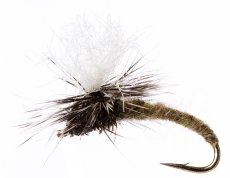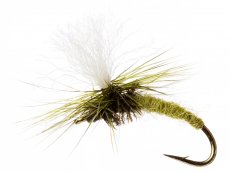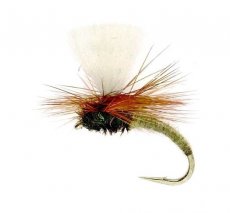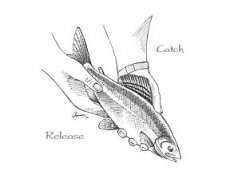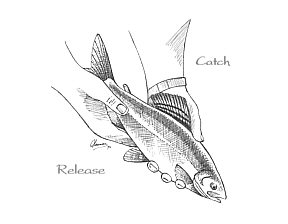Reflection on the importance of Catch and Release and practical experience from the Norwegian river Glomma.
A story about ethics
It is not difficult as a very enthusiastic fly-fisherman to talk freely about favourite rivers or fishing places, especially for me, coming from Holland where good fishing places are rare. I always try to help friends and grayling fanatics with my hot spots in Central Europe and Scandinavia and I still like it when other fly-fishermen can enjoy their fishing as much as I do. But what happens to you when you find a group of 20 fishermen on your favourite Scandinavian fishing place where you used to fish on your own? It could be a splendid fishing party with exchanging ideas and nice conversations but it seems those times are over. Instead of enjoyable sit-downs around campfires, like in the old days, I only found more empty bottles of beer and plastic waste beside the riverbank. People are changing and are not so friendly any more. The last couple of years the banks of the upper part of the Glomma River (Norway) were so crowded that the otters and beavers were only hard to spot. I even go through situations where there was a big hunt for the last few fish on a particular stretch. Situations like that decide me to go inside the wilderness further than ever! As I grow older and get closer to the nature and wildlife the catches are not that important any more and I can easily sit down for hours watching wildlife and nature and just doing nothing.
THE END OF THE SHINNING RIVER?
My most favorite river by far is the Glomma in Norway. In the past there have been days that I was fishing, walking and exploring it's banks for almost 18 hours a day. There is no river in the world where I have spent so much time at its watercourse then in this Shinning river. I have seen happen many things. The most worried I am about the large number of long trotting and float experts who visit this river each year. They use many flies on complicated but very effective flies/float systems from which I know they work well. Several of them only have one thing in mind: "Catch as many fish as possible". I have nothing against people who take two or three nice fish a day just for eating but when you see whole families who take home large bags of frozen grayling between 15 and 40 cm I feel very sad. I know several of them will be ending in the dustbin anyway. Even now with size restrictions it still happens. With a good friend of mine I count a day catch of 200 grayling taken by only 12 fishermen and put in the camping freezer with only one purpose; take them back home. One camping owner told me proudly that in the most successful week easily between 1500 and 2000 grayling will be frozen and this in an area where you will find only wild fish. I also know some people who use small minnows as bate to hunt after the super trout. They are very successful with their illegal techniques. I often had heavy discussions with them but it is hard to convince those trophy hunters. Killing fish in this part of the world is a very old tradition and the only exception seems fanatical fly-fishermen.
I come from a land which is overcrowded and where all wild salmonides are disappeared by pollution a long time ago. I know when you will take or kill every fish you catch, the grayling cannot live forever. Everyone who reads my Scandinavian stories know my feeling about the Glomma River and his tributaries. A river system, which has one of the best grayling populations in Europe, seems to be falling off more and more. The Glomma river once called by me as "the shining river" gets too much pressure during the summertime and if there will be no better control in the future I can only say that the end of the shining river is nearby.
The fishing in the north is so much different from the south that is hardly to understand for people who never made a visit over there. There are no river keepers and for the fishing police the distances are simply too far to make controls effective. The fishing is cheap and there is no stocking for grayling.
There is also another problem, which is even more important and needs not only rules from the government but also a good control. Holland had real bad liquid manure problems in the past but I never thought that Norwegian farmers could have the same ideas as some of their Dutch colleagues and put their dung in the river when there is a flood. The Glomma valley has many farmers and we only saw a few illegal pollutions during the last few years but how many times it will happen during the year and how many farmers will do it? My best friend and I once fished a mile downstream such an illegal pollution. The smell was not only awful but also brown foam bubbles covered the river over a long distance. It was like fishing in shit. We did not catch one single fish that day. Still there is a good population of grayling these days but how long can they exist against too much pressure, illegal pollution and this entire killing.
THE SECRET RIVER
But there is some positive news too. Most of my Scandinavian fishing trips are planned from maps in the beginning and better organised with all written information I can get and finally completed with the notes from my fishing dairies. Unfortunately a good map is not enough to achieve some success and therefore you always will need a long walk through the forests or beside the riverbanks to find your own favourite pools and beats. With this in my mind I found more then 10 years ago one of the best wild grayling rivers in east Norway. This river, which is hard to find and only to reach by some good footwork and a compass, is probably one of the last pieces of real wilderness in eastern Norway that I know off. The best pools are at least a couple of hours walking from the nearest road. This river has been renamed by my friends and me as the SECRET RIVER and has given us an unbelievable good evidence of the importance of catch and release.
During the last 14 years we fished the Secret River very inten sively but we put back every single fish we caught. That was the only rule we made to every one who get invited in this secret place. Because I am sure that only a few pools ever fished by locals I can prove that I am right with my catch and release theories. After all those years we still catch as many fish as in the beginning. Especially the last few years when we had some very difficult fishing in Norway due terrible weather conditions and extremely high water conditions or droughts. Conditions, which made our catches almost impossible! Cold temperatures were the reason that a good hatch of insects holds off and in an area of 50 square miles we only had some excellent fishing days at the Secret River. The same happened with hot temperatures and low water. Even my wife Ina who fished the last few years more frequently was extremely successful and caught here her biggest grayling ever. Many of my friends also can tell you of their biggest catch too. If I ever will catch the beautiful black grayling again it will be in this river. I hooked some BLACKIES every year and some of them got off and it really did not bother me. I know they are there. We had many superb days and always got a few big rewards after those long hiking trips. There are dozens of attractive pools and you always catch a good number of grayling. A black variation of my Klinkhåmer Special is my favourite. The average fish is about 40cm and the biggest fish easily reach 50cm en over.
The secret river also has its own secrets and if you think you will catch fish a second day in a successful pool you can forget it. It is impossible to get the same results as a day before and after our experience it will take at least three or four days before the fish has recovered from their fight for freedom. We have made our own rules at the Secret River and one of them is that we never fished a pool "dead". This means that we never fish that long until there are no rising fish any more. This is very important if you stay in a group and fish several days in the same area. Personally I am a very active fly-fisherman and walk several miles even during a normal fishing day. I never catch more than two or three good fish in a good pool and maybe a few more in a larger one and when you do this seriously you can fish for weeks in the same area and catch fish all the time.
In between I included a small photo session from the secret river where elk, reindeer, beavers, otters and some real fanatic grayling fishermen only make "invisible" tracks. I also hope that some of the Scandinavian fishermen will read this article and will help to keep those rivers as they should be or at least try to convince more and more people the importance of catch and release.








